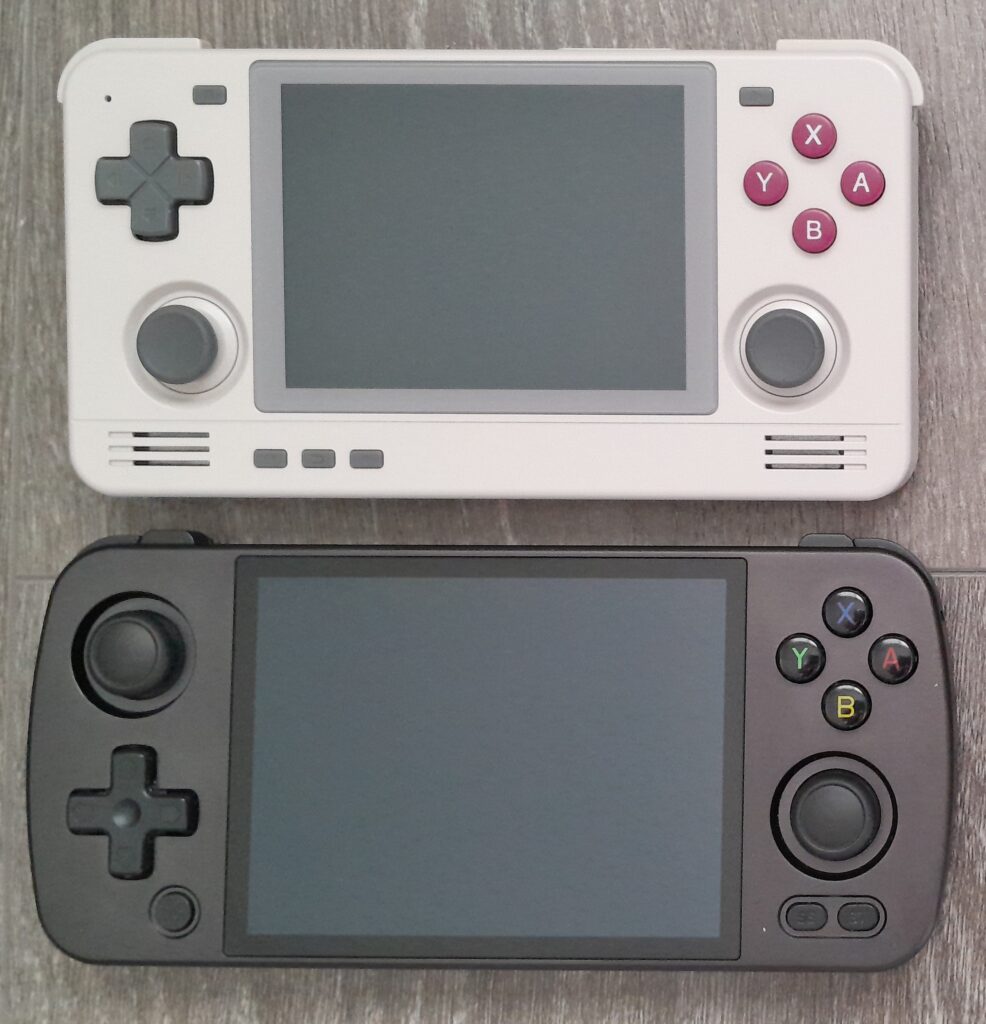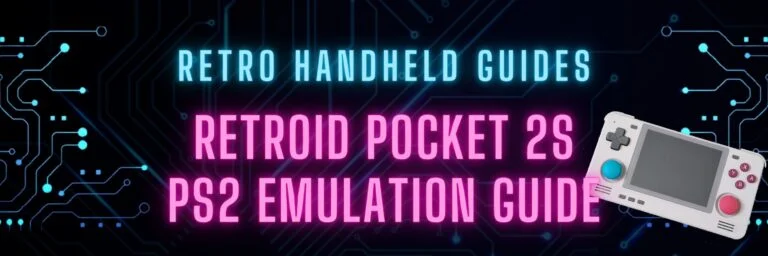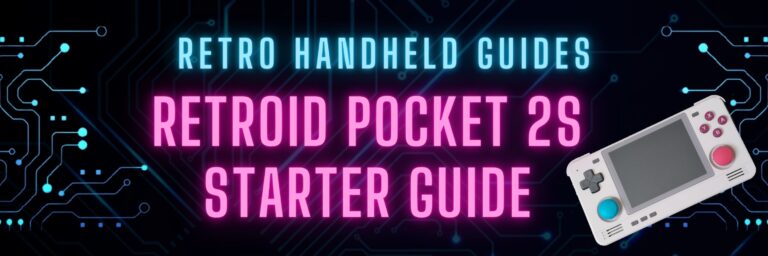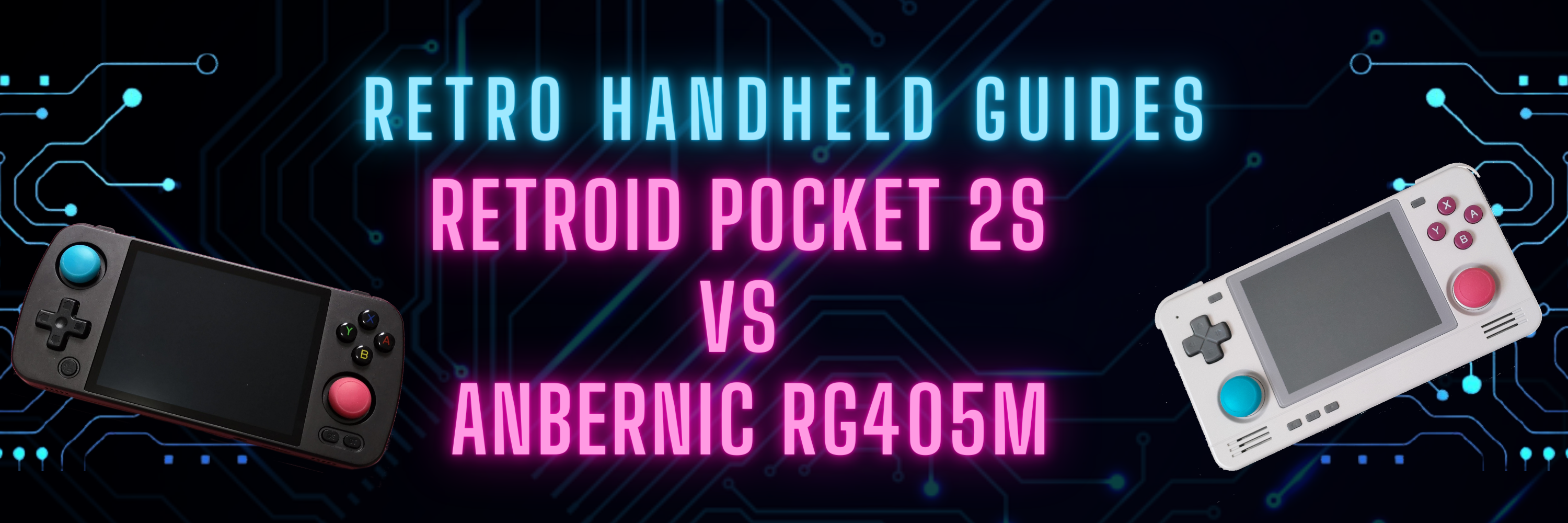RP2S vs RG405M
With the recent introduction of the Retroid Pocket 2S (RP2S) using a newer, but slightly less powerful Unisoc chip found in the RG405M and RP3+, there have been a lot of questions surrounding just how comparable these two chips are when it comes to emulation performance. Luckily, with both in hand, I have had a chance to test out my RP2S vs RG405M to see just how they compare.
Given that the Retroid Pocket 2S (RP2S) is much cheaper at $99 USD when compared to the $149 USD Retroid Pocket 3+ (RP3+) or the $177 USD RG405M, the obvious question becomes is it worth it to spend the extra money or stick with the cheaper options. In this RP2S vs RG405M comparison, I’ll share with you my experience with both and give you my opinion on which one might be right for you. So let’s dive into it!
If you are interested in learning more about the RP2S, be sure to check out my Retroid Pocket 2S Starter Guide
I also have a RG405M Starter Guide here for more information on that device as well. Be sure to check them out!
RP2S vs RG405M Specs
The Retroid Pocket 2S features a Unisoc T610 CPU clocked at 1.8GHz and a Mali G52 GPU with the option for either 3GB or 4GB of RAM.
The RG405M features a Unisoc T618 CPU clocked at 2.0GHz and a Mali G52 GPU with only a 4GB RAM model.
Both devices feature your standard Bluetooth, Wifi, and 3.5mm headphone jack and both support SD cards for storage expansion.
When comparing the RP2S vs RG405M, both devices feature a 640×480 resolution display, however, the RP2S has a 3.5″ screen versus the RG405M 4″ display area. When actually using each device, the 4″ screen of the RG405M makes quite a large difference in terms of viewing area.
In terms of video output, only the RP2S supports video out with a micro HDMI cable. The RG405M does not support video out at all.

RP2S vs RG405M Ergonomics
Button Layout
When comparing the RP2S vs RG405M in terms of comfort in the hand, both devices are pretty similar with a few keys differences of note.
First the similarities – Both devices are horizontal handhelds and both feature dual clickable hall effect joysticks, a dpad, and L1/R1 and L2/R2 functionality.
In terms of form factor and button types, that’s where the similarities end. When looking at the RP2S vs RG405M, the first major difference that you will notice is the layout of the joysticks. On the RP2S, the DPad is on top putting both of the joysticks on the bottom. On the RG405M, the DPad is on the bottom putting the left joystick in the top position and the right joystick in the bottom position.
When comparing the joystick positions, I think it really comes down to personal preference as to which one suits your needs better. I personally like to use the joystick in place of a dpad for any type of game including retro consoles that never had a joystick like the SNES or GBA. If this is your preferred play style as well then the RG405M configuration is probably going to be more comfortable to you.
If you like using the dpad for older systems and plan to mostly play those older systems on your device, then the layout of the RP2S is probably more suited to your play style.
Shoulder and Trigger Buttons
Another major difference of the RP2S vs RG405M is the shoulder and trigger configuration. The RP2S has stacked shoulder buttons which means that the L2/R2 buttons are set behind the L1/R1 buttons similar to an Xbox controller or the Nintendo Switch.
The RG405M, on the other hand, has inline buttons which are probably more similar to the Nintendo 3DS. This makes the RG405M have a slimmer profile without the stacked triggers sticking out from the case.

The L2/R2 buttons on the RP2S are also analogue meaning that you can register a smaller input when pressed lightly versus pulling the trigger fully. This works great for modern driving games where you can control the gas based on how hard you pull the trigger.
On the other hand, the RG405M has digital buttons which register as either not pressed or fully pressed. There is no nuance or finesse available for modern driving games.
In practice, unless you plan on streaming modern games to the device, analogue triggers doesn’t have much use as many of the consoles that can be emulated by these devices never had those types of inputs with the exception of the Dreamcast.
Each configuration has its benefits and drawbacks. The stacked shoulder buttons of the RP2S feel a bit more comfortable to reach and use. The inline buttons on the other hand make the RG405M slimmer and arguably more pocketable.
If you plan on playing a lot of Dreamcast driving games or streaming moderns games then the stacked triggers on the RP2S is definitely the way to go.
How does it feel in hand?
Despite the smaller screen of the RP2S vs RG405M, both devices are pretty close in terms of overall height and width with the RG405M being only very slightly wider than the RP2S.
The main reason for this is that the RP2S has much larger bezels around the screen than the RG405M. As you can see, the RG405M has minimal bezels at the top and bottom where the RP2S has a fairly large one on the bottom where the home and back buttons are located.
The joystick placement also affects how comfortable each device is. With my play style of using both sticks at the same time when combined with the stacked shoulder buttons, I actually found that the RP2S can be a bit uncomfortable over longer play sessions as it feels like a bit too much of a stretch between my thumbs on the joysticks and my index fingers reaching back to the triggers. I would consider myself to have medium sized hands but it still feels like a bit of a stretch to reach the joysticks and the triggers.
The RP2S is also made of plastic where as the RG405M is made of metal. This gives a fairly large weight difference when comparing the RP2S vs RG405M. The RG405M feels more premium and hefty in the hands whereas the RP2S feels a bit more like a toy. Not necessarily a bad thing but the RG405M definitely feels better to me.
RP2S vs RG405M Emulation Testing
Both of these devices are easily capable of emulating everything up to N64 without any issues at all. With a 4:3 ratio screen, all of these older systems also look fantastic on these handhelds. Where you will start to find the main differences between these two devices is when it comes to some of the newer systems that can be emulated like 3DS, Nintendo Switch, PS2, and Gamecube.
These newer systems push the limits of what these devices are able to emulate and neither the RP2S nor the RG405M are capable of emulating anywhere near the full library for any of the newer systems.
If you are looking for a device which is able to easily emulate PS2 or Gamecube without much effort then you should look to another, more powerful device. Both the RP2S and RG405M are capable of emulating some of the library for each of these systems but will struggle still with more demanding games.
Note: All of my RG405M testing is done on GammaOS. This operating system has much better performance over the stock system. If you are looking for more information on GammaOS, be sure to check out my RG405M Gamma OS Install Guide
Note: I am using the 3GB model of the RP2S for all of my emulation testing
RP2S vs RG405M PS2 Emulation
In my testing with PS2 emulation, using the most recent Playstore version of AetherSX2 and the Safe/Optimal settings, I surprisingly found the RP2S vs RG405M to be pretty comparable in terms of performance.
What I found in practice is that the RG405M doesn’t offer much of a boost in performance at all when it comes to PS2 emulation. If a game isn’t playable on the RP2S, it likely is not going to be any better on the RG405M. At most, I found a 1-5% increase in performance which means that you might find a game or two that is just on the cusp of 100% that can hit a pretty stable full speed on the RG405M over the RP2S but most people probably wouldn’t notice the difference.
As I mentioned earlier, I wouldn’t pick either of these systems up if you are looking to play a bunch of PS2 games, but if you keep your expectations in check, you definitely find a number of playable PS2 games.
RP2S vs RG405M Gamecube Emulation
One of the main differences when comparing Gamecube emulation on the RP2S vs RG405M is the ability to use a custom Retroid build of the Dolphin emulator called Dolphin for Handheld which comes included with the RP2S.
It is possible to also get this build onto the RG405M, however, its not widely available on the internet so the easiest method to actually get it is to transfer it from a Retroid device.
This Dolphin for Handheld build is advantageous in that it allows sub-native resolutions which is not available in the Official Dolphin builds. It also has a number of hacks built into the system to optimize it a bit more for handheld devices.
The official Dolphin build has made great leaps in the last few months to include a number of these hacks as options into the latest development builds and so the gap is closing in terms of performance.
In order to make an apples to apples comparison, I’m going to be using the latest development build of Dolphin on both devices.
Again, I found that the performance advantage of the RG405M is pretty minimal over the RP2S when it comes to Gamecube testing. At most, I found a 1-5% performance advantage and in practice I probably wouldn’t have even noticed if I didn’t have an FPS counter on.
Final Verdict
In terms of performance, both of these devices are very similar and so the advantage of paying extra for a slightly more powerful device in this case is surprisingly not a very big consideration.
With that in mind, the RP2S is an incredible device and you cannot beat its price to performance ratio. This little device has performance comparable to the RG405M and RP3+ for $50 – $80 USD less than what you would spend there.
If price is your main concern when it comes to purchasing a retro handheld device then you cannot go wrong with the RP2S.
For me personally, however, if price isn’t a huge determining factor, I would go with the RG405M easily over the RP2S.
- The metal shell makes the RG405M feel premium in the hand where the RP2S feels a bit cheap in comparison.
- The larger screen of the RG405M makes a huge difference in terms of viewing area and the smaller bezels feel like less space is being wasted.
- The inline shoulder buttons make the entire device slimmer and arguably more pocketable.
- I also prefer the dpad on bottom layout but this is personal preference and I know there would be lots of people out there that would disagree with me on that.
The only downside of getting the RG405M is that you really need to install a custom firmware to get the most out of the device. The stock os will leave performance on the table and so you really should take the time to install GammaOS if you want the get the most out of your RG405M. I’ve written a post as an RG405M Gamma OS Install Guide if you plan to go that route.
More Reading..

RP2S PS2 Emulation Guide
The Retroid Pocket 2S is a surprisingly capable mid-range emulation handheld. Based on a slightly less powerful version of the chip used in the RP3+ and…

Retroid Pocket 2S Starter Guide
The Retroid Pocket 2S is a small retro handheld device that aims to capture the under $100 (USD) market. With the same design as the Retroid…
